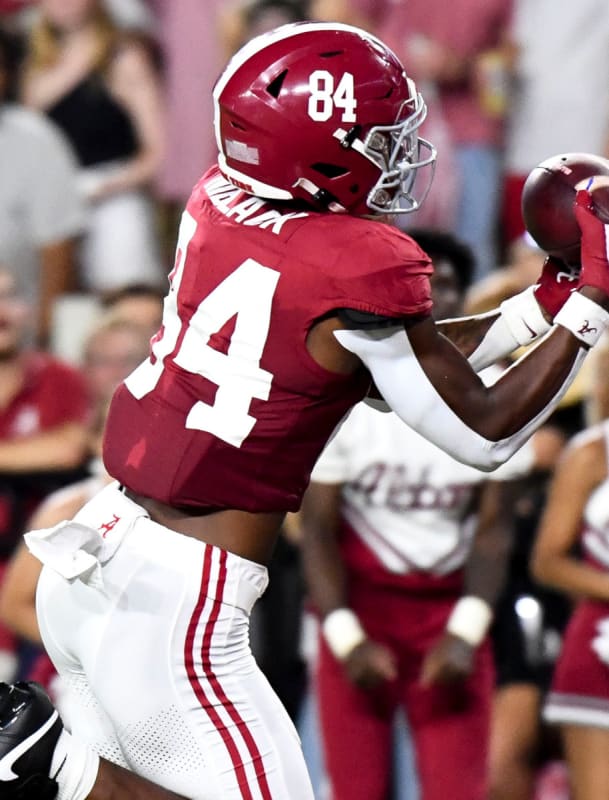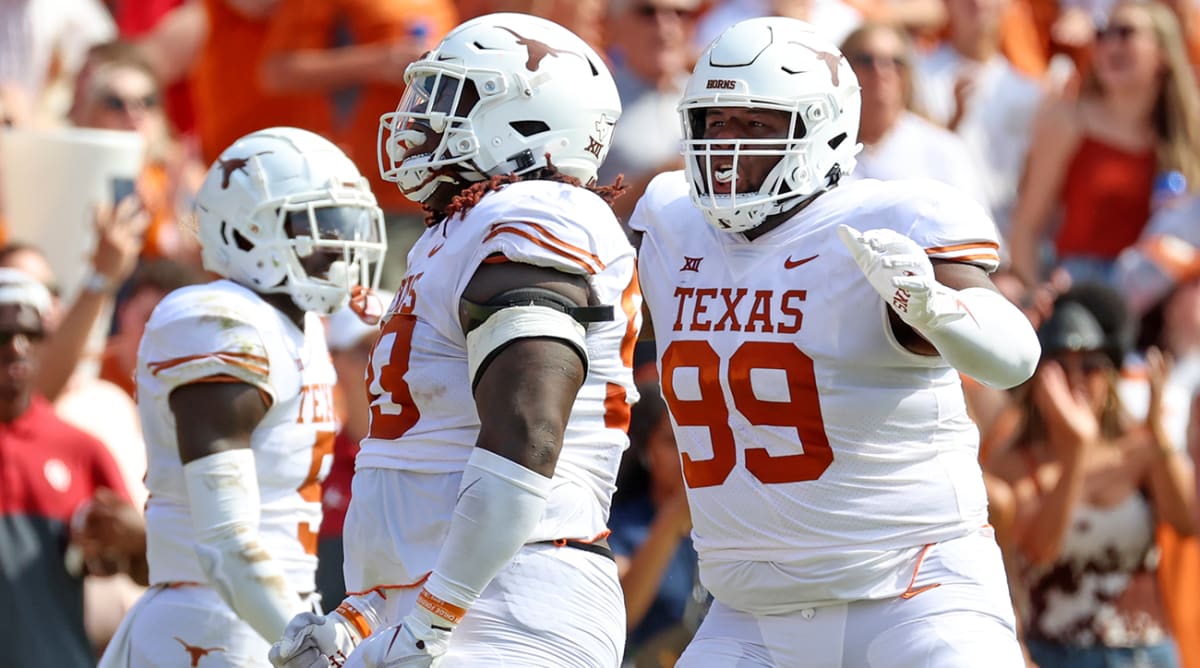Last year’s Alabama-Texas game eventually boiled down to Bryce Young’s putting the team on his back and carrying the Crimson Tide to victory in Austin. Now, the return game beckons after both teams have had a week to work out the kinks against lesser opponents.
Keys for Alabama
This Tide team is much different from last year’s. Young is gone, as is running back Jamhyr Gibbs, and in steps new offensive coordinator Tommy Rees, who is revamping Bama’s offense. Early signs point to Bama going much heavier than it has in recent years—a clear nod to the style Rees has brought from Notre Dame to Tuscaloosa, and what Nick Saban told Sports Illustrated last week is the way he thinks the pendulum of football schematics is trending back toward. It gets the Tide’s offensive identity back to something approaching Saban’s first era in charge.

Gary Cosby Jr./USA TODAY Sports
Alabama has a staggering 12 tight ends on its website roster, nine of whom dressed for the opener against Middle Tennessee; seven of them played in that game, according to Pro Football Focus. The Tide featured four of them on the first drive alone; they weren’t just garbage-time snaps. No team in the country played more tight ends in Week 1 than Bama did, and only Auburn and Oregon State matched that number. The Tigers have only seven TEs on their roster, while the Beavers have nine. The Tide likely won’t play that many against the Horns, but it shows they are committed to a different style than in recent years.
Rees’s Notre Dame offense ran nearly twice as many 12-personnel (one running back and two-tight-end sets) snaps than Alabama did last season (302 to 166), and the Tide came out in 12 on about 18.5% of their snaps in 2022. That number shot up in the Middle Tennessee game with Bama coming out in 12 on 30 of 64 snaps and 76% of its running plays. What will it mean Saturday against the Longhorns? The Tide have players who range from 230 lbs. (Amari Niblack) to nearly 260 lbs. (Robbie Ouzts), and the versatility allows Bama to have a pass catcher and a blocker on the field at the same time. Such a scheme can also help dictate the Horns’ defensive personnel, which may have to skew heavier to match the Tide like for like.
“I think we have better tight ends on our team than we’ve had in the past,” Saban told reporters after the Middle Tennessee game. “CJ [Dippre] gives us something we haven’t had, which is a good, strong, solid blocker at Y. Amari is a really good pass receiver. He made a really nice catch down the middle today. He’s improved his blocking. Danny [Lewis] is a good blocker and a good Y. Robbie Ouzts is kind of an H-back, old-fashioned fullback type of guy that can do certain things really well. So that group is, I think, much better than we’ve had in the last couple years. We’ve had to play an offensive tackle at tight end to be able to do some of the things that we’re doing now.”
Watch live sports with Fubo. Start your free trial today.
Keys for Texas
How Texas matches up physically on defense will be one of the key story lines of the game, as Bama will hope to get running back Jase McClellan going. It does not matter how good your perimeter blocking is if you can’t get to the perimeter because the interior defensive linemen have wrecked too much shop. Byron Murphy II, Vernon Broughton, T’Vondre Sweat and Ethan Burke offer the Longhorns a tantalizing group of interior defensive linemen to stand up against the Tide when they try to run the ball. They will have to contend with designed runs for quarterback Jalen Milroe in addition to his scrambling ability. Milroe’s legs make him a game changer. The biggest key will be whether Texas can make Milroe into more of a pure dropback passer than he wants to be and potentially expose the weaker part of his game. Some of that will come down to game state as well. Last year the Tide had to chase the game, but Young was able to make magic. This year we still don’t know whether Milroe has that gear.

Kevin Jairaj/USA TODAY Sports
Texas came into last year’s Alabama clash with a clear plan: Block for Quinn Ewers (often with seven or eight offensive linemen) and give him the freedom to let it rip, testing Alabama’s secondary repeatedly. It was working about as well as one could expect until Ewers took a shot in the first half and went out injured. He had thrown for 134 yards with completions of 22, 17 and 46 yards at that time.
Texas coach Steve Sarkisian can be adept at crafting a game plan for a one-game scenario such as this one—and if he’s at his most honest, he would probably say he has been doing so for much of the summer. Sarkisian’s super power on the headset, like any good play-caller, is finding individual matchups to exploit. It’s what he did in the first quarter of last year’s game with multiple deep shots from Ewers to Xavier Worthy. This year Alabama’s secondary has a minor unknown quantity to it as starting safety Jaylen Key and nickel cornerback Malachi Moore (or Star, in Bama position terminology) are injured. Saban pegged their status as day-to-day, so there may not be too much cause for concern, but if either can’t play, expect Texas to test those areas of Bama’s secondary early and often.
The under-the-radar story line in all of this is the measuring-stick factor for Texas. The Horns, SEC-bound in 2024, want to enter the conference on the front foot, and that’s more than just living up to expectations this season and contending, or even winning, the Big 12. Saturday’s meeting with Alabama is Texas’s SEC litmus test.
Last year the grade could be considered incomplete. Flunking this one would be a blow to optimism about just how ready Texas is for what’s coming.






